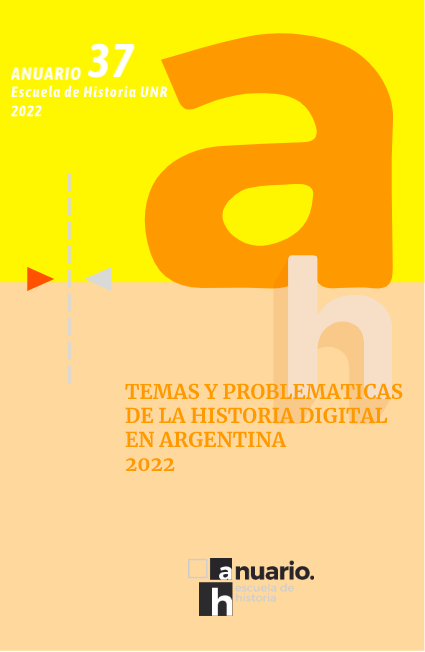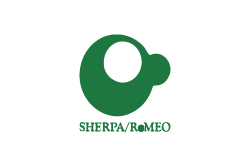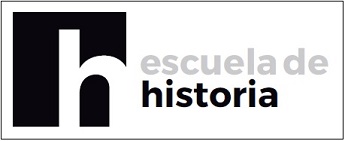Fuentes tradicionales y herramientas digitales: explorando los Diarios de Sesiones del Congreso Nacional durante el primer peronismo con Gephi
DOI:
https://doi.org/10.35305/aeh.vi37.372Resumen
Mi propuesta para este trabajo consiste en revisar los usos políticos e históricos que se hicieron de los Diarios de Sesiones del peronismo clásico, prestando atención a sus características como fuente histórica y como elemento de intervención en el debate público, para luego presentar posibles formas de análisis con herramientas digitales de uno de los registros particulares que incluyen estos documentos: los informes de las votaciones nominales que se realizaban en la Cámara de Diputados. El objetivo será no sólo reconstruir una de las dimensiones cotidianas del trabajo legislativo, sino también recuperar la utilidad que ese tipo de información tiene para pensar uno de los aspectos más controvertidos –así fue interpretado por historiadores, periodistas, analistas políticos y observadores nativos– de la experiencia peronista: la incorporación sistemática de trabajadores y dirigentes sindicales al parlamento. Más que una apuesta por redefinir la investigación histórica a través del uso de herramientas digitales, lo que quiero presentar es un análisis de unos registros poco trabajados que esté a mitad de camino entre la exploración de datos con herramientas digitales y la revisión crítica respecto de las posibilidades y dificultades que conlleva usar este tipo de software para la investigación histórica.Descargas
Citas
Andris, C. et al. (2015). The Rise of Partisanship and Super-Cooperators in the U.S. House of Representatives. PLoS ONE, 10(4). Recuperado de https://doi.org/10.1371/journal.pone.0123507
Ansolabehere, S., Snyder, J. M. & Stewart, C. (2001). The Effects of Party and Preferences on Congressional Roll-Call Voting. Legislative Studies Quarterly, 26(4), 533-572. Recuperado de https://doi.org/10.2307/440269
Ansolabehere, S. & Jones, P. E. (2010). Constituents’ Response to Congressional Roll-Call Voting. American Journal of Political Science, 54(3), 583-597. Recuperado de https://doi.org/10.1111/j.1540-5907.2010.00448.x
Belini, C. (2001). Parlamento, partidos políticos y política industrial en la Argentina, 1946-1955. Boletín del Instituto de Historia Argentina y Americana “Dr. Emilio Ravignani”, (23), 79-107.
Bianchi, S. (2001). Catolicismo y peronismo. Religión y política en la Argentina, 1943-1955. Buenos Aires: Prometeo.
Blaxill, L. (2013). Quantifying the language of British politics, 1880-1910. Historial Research, 86(232), 313-341.
Bonin, H. (2020). From antagonist to protagonista: ‘Democracy’ and ‘people’ in British parliamentary debates, 1775-1885. Digital Scholarship in the Humanities, 35(4), 759-775.
Boyd, d. & Crawford, K. (2012). Critical questions for big data. Provocations for a cultural, technological, and scholarly phenomenon. Information, Communication & Society, 15(5), 662-679. Recuperado de https://doi.org/10.1080/1369118X.2012.678878
Bucciarelli, M. (2010). Tensiones en los debates parlamentarios en torno a la provincialización de los Territorios Nacionales durante el primer peronismo. Quinto Sol, (14), 105-126.
Caimari, L. (1994). Perón y la Iglesia Católica. Religión, Estado y Sociedad en la Argentina (1943-1955). Buenos Aires: Ariel.
Calvo, E. (2014). Legislator Success in Fragmented Congresses in Argentina. Plurality Cartels, Minority Presidents, and Lawmaking. Nueva York: Cambridge University Press.
Cherepnalkoski, D. et al. (2016). Cohesion and Coalition Formation in the European Parliament: Roll-Call Votes and Twitter Activities. PLoS ONE, 11(11). Recuperado de: https://doi.org/10.1371/journal.pone.0166586
Ciria, A. (1984). Política y cultura popular: la Argentina peronista 1946-1955. Buenos Aires: Ediciones de la Flor.
Cosse, I. (2006). Estigmas de nacimiento. Peronismo y orden familiar (1946-1955). Buenos Aires: Fondo de Cultura Económica.
Cox, G. W. & Poole, K. T. (2002). On Measuring Partisanship in Roll-Call Voting: The U.S. House of Representatives, 1877-1999. American Journal of Political Science, 46(3). Recuperado de https://doi.org/10.2307/3088393
Cribb, V. M. & Rochford, S. (2018). The Transcription and Representation of Spoken Political Discourse in the UK House of Commons. International Journal of English Linguistics, 8(2). Recuperado de http://doi.org/10.5539/ijel.v8n2p1
Dal Maso, C. et al. (2014). Voting Behavior, Coalitions and Government Strength through a Complex Network Analysis. PLoS ONE, 9(12). Recuperado de https://doi.org/10.1371/journal.pone.0116046
Engelhardt, B. (2013). El congreso durante los primeros años de la presidencia de Perón (1946-1949). En Mustapic, A. M., Bonvecchi, A. & Zelaznik, J. (coords.). Los legisladores en el Congreso Argentino: prácticas y estrategias. Buenos Aires: Instituto Torcuato Di Tella, 211-251.
Erickson, R. S. (1971). The Electoral Impact of Congressional Roll Call Voting. American Political Science Review, 65(4), 1018-1032. Recuperado de https://doi.org/10.2307/1953495
Ferrari, M. (2008). Los politicos en la república radical. Prácticas políticas y construcción de poder. Buenos Aires: Siglo XXI.
Fowler, J. H. (2006). Connecting the Congress: A Study of Cosponsorship Networks. Political Analysis, 14(4), 456-487. Recuperado de https://doi.org/10.1093/pan/mpl002
García Sebastiani, M. (2001). Peronismo y oposición política en el parlamento argentino. La dimensión del conflicto con la Unión Cívica Radical (1946-1951). Revista de Indias, 61(221), 27-66.
Jacomy, M. (2021). Situating Visual Network Analysis (Tesis de doctorado inedita). Aalborg University. Recuperado de https://reticular.hypotheses.org/1879
Jacomy, M. & Jokubauskaité, E. (2021, en prensa). Unblackboxing Gephi: How user cultures shape their scientific instruments. Science as Culture. Reproducido en Jacomy, M. Situating Visual Network Analysis…
Jacomy, M., Venturini, T., Heymann, S. & Bastian, M. (2014). ForceAtlas2, a Continuous Graph Layout Algorithm for Handy Network Visualization Designed for the Gephi Software. PLoS ONE, 9(6). Recuperado de https://doi.org/10.1371/journal.pone.0098679
López Pascual, J. (2016). Arte y trabajo. Imaginarios regionales, transformaciones sociales y políticas públicas en la institucionalización de la cultura en Bahía Blanca (1940-1969). Rosario: Prohistoria.
Luna, F. (1984). Perón y su tiempo. La Argentina era una fiesta. Buenos Aires: Sudamericana.
Lyons, P. & Lacina T. (2009). An Examination of Legislative Roll-Call Voting in the Czech Republic Using Spatial Models. Sociologický Časopis / Czech Sociological Review, 45(6), 1155-1190. Recuperado de https://doi.org/10.13060/00380288.2009.45.6.01
Micozzi, J. P. & Saiegh, C. (2017). La estructura radial del conflicto político: el juego imposible en Argentina (1955-1966). Revista de la Sociedad Argentina de Análisis Político, 11(2), 253-282.
Míguez, E. (1995). Microhistoria, redes sociales e historia de las migraciones: ideas sugestivas y fuentes parcas. En Bjerg, M. & Otero, H. Inmigración y redes sociales en la Argentina moderna. Tandil: CEMLA-IEHS.
Moretti, F. (2013). Distant Reading. Londres: Verso Books.
Poole, K. T. (2005). Spatial models of parliamentary voting. Nueva York: Cambridge University Press.
Poole, K. T. & Rosenthal, H. (2000). Congress: A political-economic history of roll call voting. Nueva York: Oxford University Press.
Porter, M. A. et al. (2007). Community structure in the United States House of Representatives. Physica A: Statistical Mechanics and its Applications, 386(1), 414-438. Recuperado de https://doi.org/10.1016/j.physa.2007.07.039
Prol, M. M. (2011). Los legisladores sindicales peronistas. Entre la práctica partidaria, la corporativa y la legislativa, 1946-1955. PolHis, 4(7), 132-139.
Rieder, B. & Röhle, T. (2017). Digital methods: from challenges to Bildung. En Schäfer, M. & van Es, K. (eds.). The Datafied Society. Studying Culture through Data. Amsterdam: Amsterdam University Press.
Rodríguez Cordeu, J. (2020, en prensa). La Confederación General del Trabajo y el bloque peronista en la Cámara de Diputados del Congreso Nacional, 1946-1955. En Contreras, G. N. (comp.); La CGT y el peronismo. Prácticas gremiales, institucionales y políticas de la Confederación General del Trabajo, 1946-1955. Buenos Aires: Prometeo.
Rosenthal, H. & Voeten, E. (2004). Analyzing Roll Calls with Perfect Spatial Voting: France 1946-1948. American Journal of Political Science, 48(3), 620-632. Recuperado de https://doi.org/10.1111/j.0092-5853.2004.00091.x
Santilli, D. (2003). Representación gráfica de redes sociales. Un método de obtención y un ejemplo histórico. Mundo Agrario, 3(6).
Schoch, D. & Brandes, U. (2020). Legislators’ roll-call voting behavior increasingly corresponds to intervals in the political spectrum. Scientific Reports, 10(1). Recuperado de https://doi.org/10.1038/s41598-020-74175-w
Smith, P. H. (1974). Argentina and the Failure of Democracy. Conflict among Political Elites, 1904-1955. Madison: The University of Wisconsin Press.
Snyder, J. M. & Groseclose, T. (2000). Estimating Party Influence in Congressional Roll-Call Voting. American Journal of Political Science, 44(2), 193-211. Recuperado de https://doi.org/10.2307/2669305
Thomas, M. (1985). Election Proximity and Senatorial Roll Call Voting. American Journal of Political Science, 29(1), 96-111. Recuperado de https://doi.org/10.2307/2111213
Vezub, J. (2019). El Análisis de Redes Sociales (ARS) en la investigación histórica. En Salomón Tarquini, C. et al. El hilo de Ariadna. Propuestas metodológicas para la investigación histórica. Buenos Aires: Prometeo.
Publicado
Cómo citar
Número
Sección
Licencia
Derechos de autor 2022 Joaquín Rodríguez Cordeu

Esta obra está bajo una licencia internacional Creative Commons Atribución-NoComercial-CompartirIgual 4.0.
Los autores que publican en esta revista están de acuerdo con los siguientes términos:
Al momento de enviar sus contribuciones, los colaboradores deberán autorizar su publicación conservando los derechos de autoría, y transfiriendo a la revista todos los derechos protegidos por las leyes de propiedad intelectual que rigen en Argentina, que implican la edición para difundir la obra en soporte digital en que se aloja la revista. Deberán declarar que poseen el permiso del archivo o repositorio donde se obtuvieron los documentos que se anexan al trabajo, cualquiera sea su formato (manuscritos inéditos, imágenes, archivos audiovisuales, etc.), permiso que los autoriza a publicarlos y reproducirlos, liberando a la revista y sus editores de toda responsabilidad o reclamo de terceros.
Asimismo, los autores deben adherir a la licencia Creative Commons denominada “Reconocimiento - No Comercial- Compartir Igual CC BY-NC-SA”, mediante la cual el autor permite copiar, reproducir, distribuir, comunicar públicamente la obra y generar obras derivadas, siempre y cuando se cite y reconozca al autor original. No se permite, sin embargo, utilizar la obra con fines comerciales. Los autores podrán establecer acuerdos adicionales para la distribución no exclusiva de la versión de la obra publicada en la revista (por ejemplo, situarlo en un repositorio institucional o publicarlo en un libro), con el reconocimiento de haber sido publicado primero en esta revista.



.png)







1.jpg)
.png)













.svg_1.png)




1.png)
